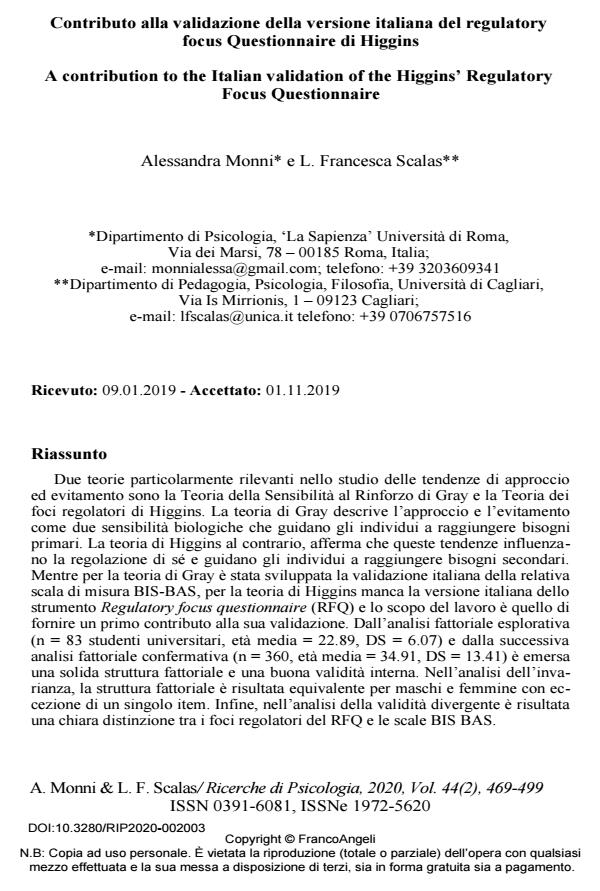A contribution to the Italian validation of the Higgins’ Regulatory Focus Questionnaire
Journal title RICERCHE DI PSICOLOGIA
Author/s Alessandra Monni, L. Francesca Scalas
Publishing Year 2020 Issue 2020/2
Language Italian Pages 31 P. 469-499 File size 310 KB
DOI 10.3280/RIP2020-002003
DOI is like a bar code for intellectual property: to have more infomation
click here
Below, you can see the article first page
If you want to buy this article in PDF format, you can do it, following the instructions to buy download credits

FrancoAngeli is member of Publishers International Linking Association, Inc (PILA), a not-for-profit association which run the CrossRef service enabling links to and from online scholarly content.
Gray’s Reinforcement Sensitivity Theory and Higgins’ Regulatory Focus The-ory are two of the most relevant theories on approach and avoidance tendencies. Gray’s theory considers approach and avoidance as biological sensitivities that guide individuals to reach primary needs. Higgins’ theory, on the contrary, states that approach-avoidance tendencies influence self-regulation and guide individ-uals to reach secondary needs. While the Italian validation of the BIS-BAS scale relative to Gray’s theory has been developed, an Italian version of the Regulato-ry focus questionnaire (RFQ) relative to Higgins theory has not been developed yet. The aim of our study is to provide a contribution to develop an Italian ver-sion of the RFQ. From the exploratory factorial analysis (n = 83 university stu-dents, mean age = 22.89, DS = 6.07) and the subsequent confirmatory factorial analysis (n = 360, mean age = 34.91, DS = 13.41), a solid factorial structure and a good internal validity emerged. In the invariance analysis, the structure was partially equivalent across genders, except for a single item. Finally, the examina-tion of divergent validity showed that the regulatory foci identified by RFQ are constructs distinct from the ones identified by the BIS-BAS scale. In conclusion, our Italian version of the RFQ shows satisfactory psychomet-ric properties and parsimonious structure, and thus seems to be a valuable in-strument for measuring approach-avoidance according to Higgins’ theory.
Keywords: Promotion focus, prevention focus, Regulatory Focus Questionnaire.
- Approach-Avoidance Assessment: Comparison and Validity of the Measures Related to Three Theories Alessandra Monni, L. Francesca Scalas, in Psychological Studies /2024 pp.145
DOI: 10.1007/s12646-024-00786-2 - Health Risk Behaviour Inventory Validation and its Association with Self-regulatory Dispositions Alessandra Monni, L. Francesca Scalas, in Journal of Clinical Psychology in Medical Settings /2022 pp.861
DOI: 10.1007/s10880-022-09854-z
Alessandra Monni, L. Francesca Scalas, Contributo alla validazione della versione italiana del regulatory focus Questionnaire di Higgins in "RICERCHE DI PSICOLOGIA " 2/2020, pp 469-499, DOI: 10.3280/RIP2020-002003